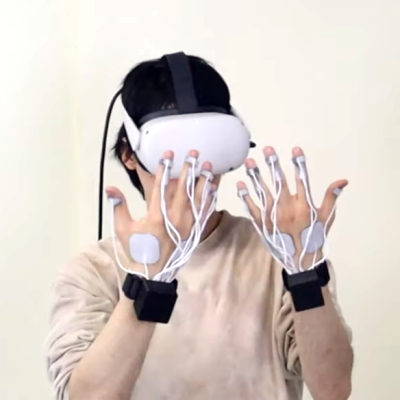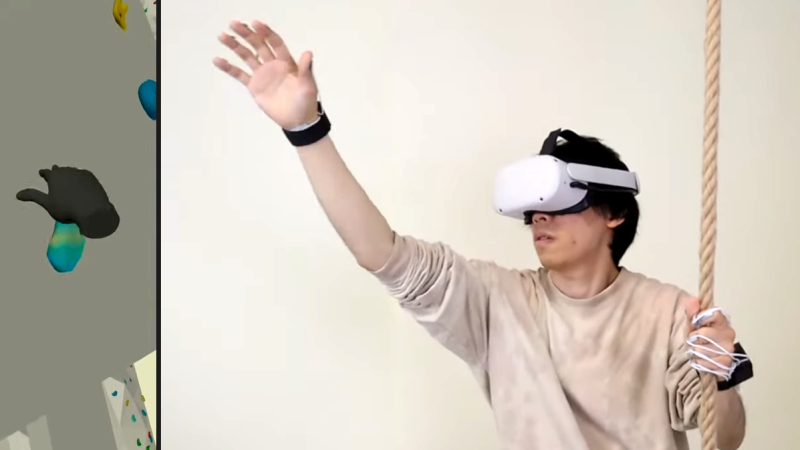This clever research from the University of Chicago’s Human Computer Integration Lab demonstrates a fascinating way to let users “feel” objects in VR, without anything getting in the way of using one’s hands and fingers normally. Certainly, the picture here shows hands with a device attached to them, but look closely and you’ll see that it’s on the back of the hand only.

The unique device consists of a control box, wires, and some electrodes attached to different spots on the back of the hand and fingers. Carefully modulated electrical signals create tactile sensations on the front, despite originating from electrodes on the back. While this has clear applications for VR, the team thinks the concept could also have applications in rehabilitation, or prosthetics.
The way it works is pretty clever. Electrical signals traverse the tissues of the hand, passing through nerves in both the front and back. But the front (palmar) side of the hand has roughly 60 times more receptors than the back, which makes the front of the hand far more sensitive. Even though the same electrical stimulus is hitting both sets of nerves, the sensation is overwhelmingly felt and localized at the front of the hand, despite originating from the back.
With careful modulation, sensations at 11 different points can be reliably targeted in this way. It’s possible to feel the touch of a button or the shape of a non-existent object in VR, all without interfering with how the hand normally works. In fact, one demo shows the user molding a lump of clay while still being able to distinctly feel the tactile feedback created by this system.
The sensations felt are still “phantom” touches (in the sense that there is no force behind them) so it cannot constrain the user physically the way a glove with actuators can. But not having anything obstructing the normal function of hands and fingers is a powerful advantage.
There’s a short video embedded below that demonstrates things, so give it a watch. And for those who crave nitty-gritty details, here’s a link to the research paper.
















As neat as the idea is, I, for one, don’t want to don one single item on me unless they can first make the headsets far less of a nuisance. I mean, the headsets currently are so much of an uncomfortable nuisance as they are that I don’t want even a tiny bit more added to that, no matter where on my body it’d be.
Yeah, but things like the bigscreen beyond are nowhere near being portable. Rn the best we can hope for is a beyond connected wirelessly to a portable pc or laptop
We’ve got a free-roam zero latency VR place near us. Big warehouse, racks of PCs somewhere running wireless headsets. Guns are tracked so no hand controllers. Once you’re in a game, you don’t notice the headset. Only issue with it is that weirdly the voice chat has got an annoying lag, even though the tracking and video and SFX doesn’t.
I agree that VR can be a process to get set up and just sitting down and playing a game is far easier. But when you find a game that is worth the hassle it Is really worth it. I hope that in the future gloves with this kinda tech are made more compact and consumer friendly. Imagine a game like build with this sorta stuff In mind. it’d be revolutionary.
I don’t see why this sort of concept needs limiting to VR – a glove that can give you that sort of feedback could be useful for many things. From the most basic being silent notifications, left pinkie means its not an important contact that just messaged you, right index means this is the calendar alert, perhaps even a braile/morse like readout, up to giving feedback to the remote/heavy tools you are operating on to the full VR/AR experiences.
> The sensations felt are still “phantom” touches (in the sense that there is no force behind them) so it cannot constrain the user physically the way a glove with actuators can.
Probably just a matter of time until devices like these also control the antagonistic muscles to limit movement.
I am a sim racing and flight sim enthusiast. Being able to interact with virtual button boxes and the dials and switches on the virtual center console of a vehicle would add a another level of immersion to what is already a mind-blowing experience.
TLDR it’s zapping your fingers. no thanks.
The issue with all electrical stimulation-based haptic devices is that the gap between the sensation threshold and the pain threshold is very small and there is often a lot of delicate adjustment required to stay below the latter.